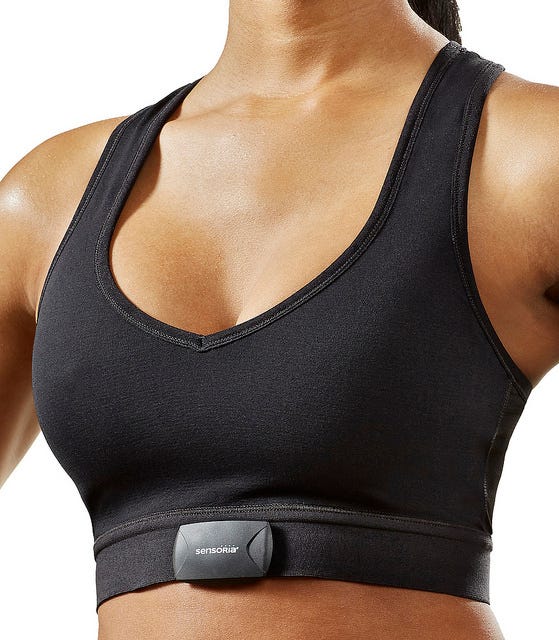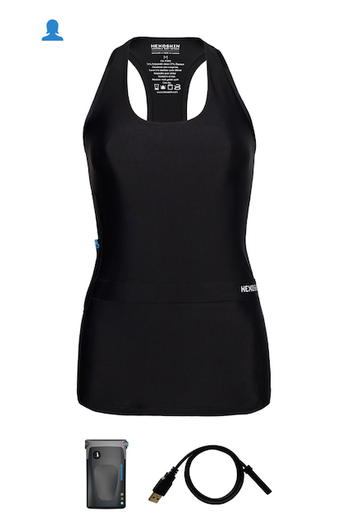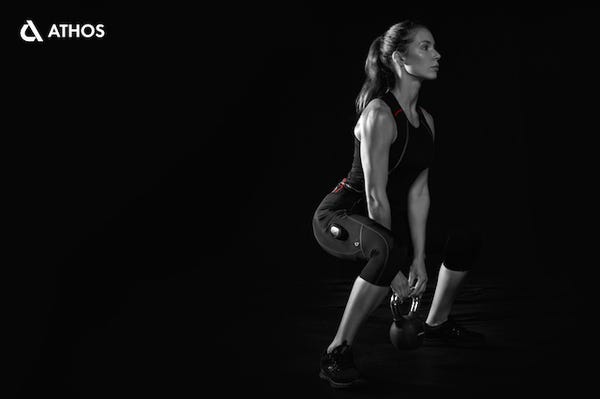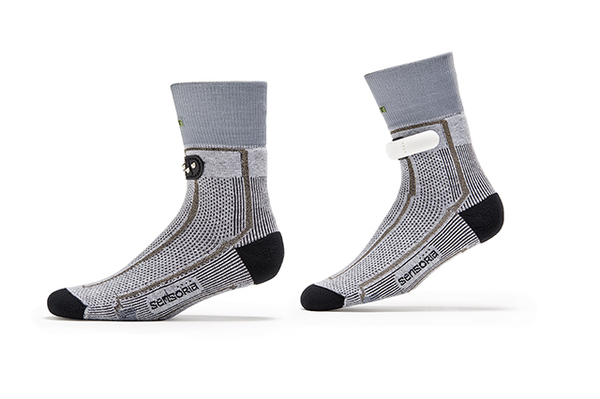 The bra came first. It was an otherwise ordinary compression sports bra, but for two small differences: metal snaps at the lower center and copper-colored threads woven into the inside band. I yanked it down around my rib cage, snapped in a heart rate monitor, launched an app on my phone, connected it to the bra via Bluetooth, and began my workout. Why buy a chest-strap heart rate monitor when you can get the same functionality from a bra, which you have to wear anyway? Smart clothing suddenly seemed, well, very smart.
The bra came first. It was an otherwise ordinary compression sports bra, but for two small differences: metal snaps at the lower center and copper-colored threads woven into the inside band. I yanked it down around my rib cage, snapped in a heart rate monitor, launched an app on my phone, connected it to the bra via Bluetooth, and began my workout. Why buy a chest-strap heart rate monitor when you can get the same functionality from a bra, which you have to wear anyway? Smart clothing suddenly seemed, well, very smart.Soon after, I found myself wearing a tank top that calculated my respiration rate, a pair of capris that knew I could handle more weight during squat drills, socks that scolded me when I ran flat-footed, and a piece of jewelry that reminded me when my period was due.
As a fitness tracker expert, I was excited to throwaway step-counting wristbands in favor of a great pair of leggings that could capture the same data, and more. It only makes sense to embed sensors into the very fabric we already wear every day. But my initial fascination with smart clothing began to wear thin when I stopped thinking about them as new toys and felt how itchy, ugly, and ill-fitting some of them were. And as with any other clothing, I worried certain pieces were completely unflattering. Add to that the fact that these sensors on my body were observing my every step and breath, and suddenly, it was a lot to bear.
Connected clothing shows so much promise as a category, but it has to work for women to be a success. So, what's it like to actually wear a bra that talks back? The future awaits, ahead!

Bra: Sensoria Sports Bra + HRM
Cost: $139
The Sensoria Sports Bra is the first piece of connected clothing I ever wore. It's simple and straightforward: It replaces the old chest-strap heart rate monitor (HRM) in favor of one that's built into the bra itself.
When I snap on a device at the breastbone, the bra band is already tight around the rib cage, where it needs to be. Conductive fabric in the band reads my pulse and delivers it to the HRM, which transmits it wirelessly via Bluetooth or ANT+ to an app or runner’s watch. The technology works, but the bra is way too tight under my armpits, restricts motion in my upper back, and has an ugly green logo on the front.
Since I first tried the Sensoria bra, the company has revised the design to make the bra more attractive and better fitting. The updated version ditches the logo and adds more room in the shoulders. At $139, the price is completely off-putting, but it does include the HRM, which costs about $60 if bought separately.

Shirt: Hexoskin Full Kit
Cost: $399
While the sports bra is a one-trick pony capturing nothing more than heart rate, a smart tank top by Hexoskin is a soup-to-nuts tracker. This workout top comes with a little battery pack that doubles as an all-day step counter and sleep tracker at night.
I tuck the lightweight pack (smaller than a credit card, but thicker) into an interior pocket at the waist. It's wired to some nearly invisible sensors that measure heart rate and breathing. The pack transmits data wirelessly to a mobile app. For $399, the kit includes one shirt, the battery device, and a charging cable.
I suit up and turn on all the components. Soon, my heart rate appears in the app, ticking up and down every few seconds. I inhale, and a set of lungs in the app expands as I do. Neat. Then I peer down at my own real-life chest as it heaves. My boobs swim in polyamide microfiber fabric. I look like a child who has put on her mother's bathing suit. Sensors line the elastic band of a built-in sports bra (if you can call it that), and a few more encircle the waist. A little belt made of the same bathing-suit material is supposed to hold the waistline sensors against the skin, but it rides up on me every time I move.
The tank is entirely black and kind of ugly. Maybe a more buxom woman would feel confident wearing this workout top, but I certainly do not.

Jewelry: Bellabeat Leaf
Cost: $129
In its form, the Bellabeat Leaf is similar to a more classic activity monitor than the clothing I’ve tested, but it stands out for being simply stunning and for tracking one essential piece of health data I have yet to see in any other device: menstruation.
I enter the dates of my period into a companion app and it figures out my cycle, marking fertile days, ovulations, and other reproductive info onto a calendar. There's an option to program the Leaf to vibrate once a day as a reminder to take the pill. I love that it has these health features, which normalizes the very act of tracking them. The message is: Your period, fertility, and birth control are just as important as the number of steps you take.
The device itself is a clip, a wooden box on the back, and a beautiful stainless-steel or rose-gold leaf on the top. I slide it onto my shirt at the neckline to wear as a brooch. My turquoise shirt pops through the cutout. It's gorgeous. An included chain and caramel-colored strap can turn the Leaf into a necklace or bracelet.
The app includes some stress-reducing breathing exercises, too. I hook the Leaf onto my waistband, pop in some earbuds, and calm myself as the app coaches me to breathe deeply.
I could squawk about the Leaf's shortcomings as a fitness tracker. It captures limited data; it doesn’t even record calories consumed. But I feel happy to wear it and to be reminded (especially as a female tech writer surrounded by men) that period-tracking should be included in all health-tracking apps.

Jewelry: Netatmo June
Cost: $129
Once a year, I go to a dermatologist and have skin cut from my body and biopsied, because I’m extremely fair and have a family history of skin cancer. I’m the kind of gal who burns through white T-shirts. A gorgeous accessory called June, from Netatmo, was made for women like me. It looks like edgy jewelry, but is, in fact, a sun-exposure alert system.
I wind a jet-black strap twice around my wrist and fasten it so that a gunmetal ornament faces skyward. It also comes in platinum and gold, but the gunmetal looks really sexy. I notice a few tiny holes, little skylights letting in UVA and UVB rays for the technology inside to monitor. A companion mobile app asks a few questions to determine my sun sensitivity level. Then, June gets to work keeping track of how long I’ve been in the sun, when I should reapply sunscreen, and whether I need a hat or sunglasses. The app tells me to cover up well before I hit 100% of my daily exposure.
Fashionable? June is downright hot. Useful? Eh. I wish the device itself vibrated to let me know when I need to cover up, rather than relying on push notifications through the app. And it would make so much more sense if June were waterproof (it's not), so I could wear it at the pool and beach.

Pants: Athos Lower Body Package
Cost: $348
Every time a weightlifting buddy has said, “You can handle more weight!” I’ve thought, You do not know my body. You do not know how this feels. I don't want to hurt myself.
The day I wiggle my butt into a pair of Athos capris is the day I realize just how strong I am. I get comfortable on a squat machine. The pants have sensors inside that measure electromyography in the glutes, inner and outer quads, and hamstrings. I set the machine to my usual weight, squat, and watch a pair of legs in the app light up blue and yellow, a sign that the muscles aren't working very hard. In other words, I can lift more — a lot more. I’m safe until the on-screen legs flash white.
For the first time in my life, I trust this "trainer" and add 40 pounds. The pants are objective. It's just a data point to them. I’m in the green zone now. I add another 10 pounds. It’s hard. It burns. But I smile with accomplishment.
The Athos pants are the most impressive piece of smart clothing I’ve worn. And unlike the other options I tried out, these act like a companion, rather than a gadget. They give meaningful feedback that empowers me in the gym. They know when I favor one leg, when I’m not engaging a certain muscle, and my heart rate.
Unfortunately, they only come in all black and are very expensive. For $348, you get one pair of pants, a device that transmits data from the pants to your smartphone, and a charging cable. What's more, getting into them is as tough as putting on a wetsuit. They need to be tight for the sensors to make good, constant contact with the skin, which also means I can’t wear anything more than a thong underneath.

Socks: Sensoria Fitness Bundle
Cost: $199
These high-end sports socks by Sensoria are designed for runners. They are easily my favorite piece of connected clothing that I’ve worn, though they are also the harshest critics. They track typical running data, like speed and distance, but also work to correct form.
I pull the thick, plush socks onto my feet and snap into place a flexible ankle cuff that transmits data in real time to an app.
On my first jog, I'm wearing not only the socks and ankle cuff, but also headphones to get real-time feedback on my running form. I enable a metronome feature, which helps me find my rhythm. It quiets down until I fall off pace, and then it ticks at me like a schoolteacher clicking her tongue in disapproval. I struggle to find a comfortable cadence when an automated voice yells at me for not running on the balls of my feet. I correct my footfalls, only to hear the ticking return a few minutes later.
Initially, the reminders do their job, but after four or five runs, I begin to wish the automated voice would cut me some slack or mix in some positive feedback when I’m running correctly. I only hear from her when something’s wrong. I forget what it’s like to let my mind wander while I’m running.
But the socks are too comfortable to give up. They make me want to run more, even if the app doesn’t. Still, I wish all my smart clothes gave me more positive feedback and encouragement.
Like what you see? How about some more R29 goodness, right here?
Einstein's Theory Of Relativity Was Just Proven Correct
7 Amazing Tricks Only Netflix Pros Know
79 New Emoji Contestants Might Arrive In 2017